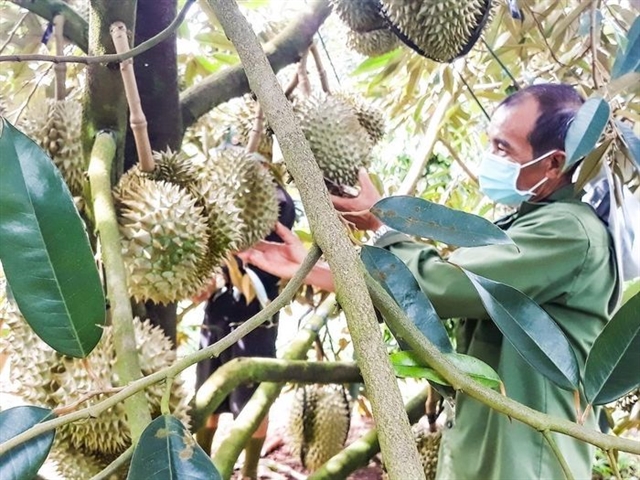 Economy
Economy


|
| Durian grown in Tiền Giang Province, the country’s largest durian producing province. —Photo baomoi.com |
HCM CITY — Farmers have been warned not to massively expand cultivation areas for durian and dragon fruit after prices for the fruits surged, instead they should focus on improving quality standards to boost exports to China.
Officials said the surge in prices is only temporary and that the price might drop in the future due to competition from other markets such as Thailand and Malaysia.
Farmers in the Cửu Long (Mekong) Delta province of Tiền Giang are currently getting high prices for their off-season durian and dragon fruit because of high demand for exports and in the domestic market.
Đặng Phúc Nguyên, general secretary of the Vietnam Fruit and Vegetable Association, said instead of expanding durian growing area, farmers need to focus on improving the quality of commercial durian to meet the standards of the Chinese market.
He recommended farmers and businesses strictly comply with market regulations to avoid violations when exporting to China, which has become a fastidious market with strict standards.
Last September, China and Việt Nam signed an agreement in which the former exports durian to the latter via an official channel.
To be eligible for exporting to China officially, durian for export must be granted codes for farming and packaging by China.
Also durian trees must be planted for at least five years and must not be intercropped.
China has approved more than 110 codes for durian farming and packaging areas in Việt Nam, up from 76 last September.
To get the code, an area must be at least 10ha in size and planted according to Vietnamese good agricultural practices (VietGAP).
It’s also important to instruct durian farmers to adopt GAP and other high quality standards and increase mechanisation.
Exporting via the official channel means exporters and buyers sign a contract before delivery and farmers face lower risks.
Meanwhile, under unofficial exporting, the fruits are transported to the border but might be sent back if the quality is deemed low, or if there are no buyers, causing huge losses for farmers.
Most durian is exported to China unofficially and in refrigerated trucks.
It is vital for Vietnamese durian farmers to build strong brands to compete with Thai and Malaysian durian brands in China, experts said.
Quality has become more important than ever because China has become much stricter on plant quarantine, and food safety and hygiene.
Prices of durian and dragon fruit have tripled year-on-year to VNĐ200,000 (US$8.5) and VNĐ40,000, respectively, per kg, in the Mekong Delta, which are the highest levels ever.
China is Việt Nam’s main export market for both durian and dragon fruit, so when it eased trade restrictions, prices jumped.
Since January, Chinese customs has no longer required goods to be tested for COVID-19 at border gates with Việt Nam, and it has also lifted all other pandemic measures.
Experts recommended in addition to the Chinese market, it is important to step up promotion to diversify export markets of vegetable and fruit, especially durian and dragon fruits.
He added it was also vital to develop the domestic market through supermarket chains to reduce dependence on China.
Vegetable and fruit exports to China reached more than $1.5 billion last year, down 20 per cent year-on-year.
Exports of vegetables and fruits to China are expected to increase by at least 20-30 per cent in 2023, of which exports of dragon fruit and durian are expected to reach $1 billion each by the end of the year. — VNS




